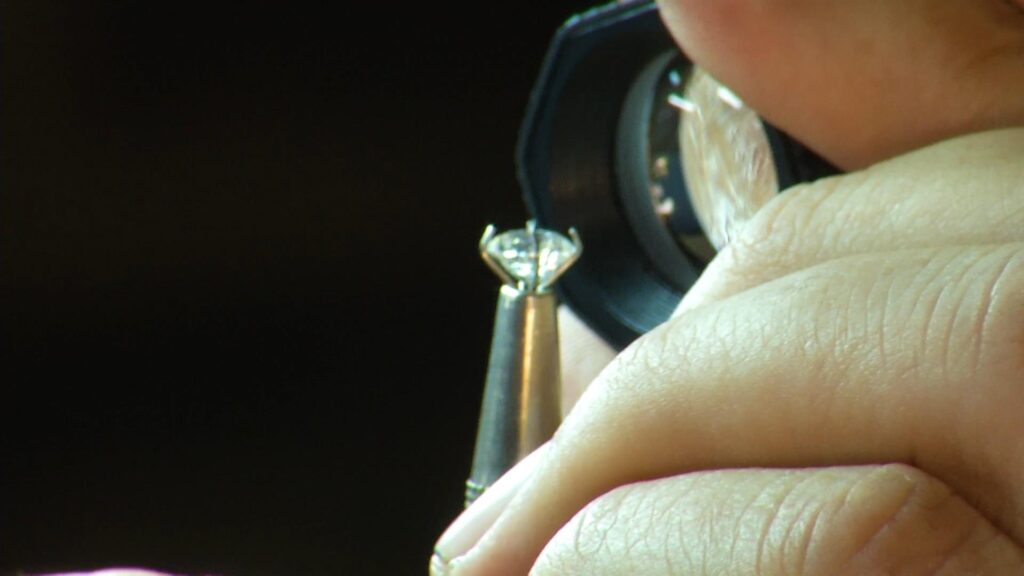Diamonds have long been symbols of luxury, love, and beauty, but the journey that a rough diamond takes before it reaches its sparkling, polished form in a jewelry store is a fascinating and intricate process. From the depths of the Earth to the hands of a consumer, a diamond’s transformation involves a series of steps, each requiring skill, expertise, and precision. In this blog, we will walk you through the captivating journey of a rough diamond, from its discovery in the mine to its final place in the market.
1. Discovery: Unearthing the Rough Diamond
The journey of a diamond begins deep beneath the Earth’s surface. Diamonds are formed under extreme pressure and temperature conditions, typically 90 to 120 miles below the surface, where carbon atoms crystallize over millions of years. The process of diamond formation can take billions of years, which is why diamonds are considered such rare and precious stones.
Mining: Where the Journey Begins
Once formed, diamonds are carried to the Earth’s surface through volcanic eruptions, where they are trapped in kimberlite pipes — deep vertical channels of volcanic rock. This is where mining companies begin their search for rough diamonds. There are several types of mining methods used to extract rough diamonds:
-
Open-Pit Mining: This method involves removing large sections of earth to access diamond-bearing kimberlite pipes. This type of mining is usually conducted when the diamond deposits are near the surface.
-
Underground Mining: For deeper diamond deposits, underground mining is used, where tunnels are drilled to reach the kimberlite pipes.
-
Alluvial Mining: This technique is used when diamonds are found in riverbeds or beaches. Diamonds are extracted from gravel deposits and carried by water.
-
Marine Mining: This method involves using specially designed vessels to mine diamonds from the ocean floor.
Once the rough diamonds are extracted from the earth, they are carefully sorted and transported to processing centers for sorting and further examination.
2. Sorting: Identifying Potential
After extraction, rough diamonds are sorted based on their size, shape, color, and quality. Mining companies typically use both human expertise and advanced technology to assess the rough stones and categorize them into different groups. The key factors considered during sorting include:
- Size: Larger diamonds have more value because they are rarer and can often be cut into multiple stones.
- Shape: The rough diamond’s shape will dictate the most appropriate cutting method, and whether the stone can be cut into a specific shape (round, oval, emerald, etc.).
- Color: While the color of a rough diamond may not be as apparent as in its polished form, it is still assessed during the sorting process.
- Clarity: Inclusions and imperfections are examined closely as they will affect the final quality of the polished diamond.
- Potential for Cutting: Some rough diamonds are too small or have too many imperfections to be cut into high-quality stones and may be set aside for industrial use.
After sorting, diamonds are sent to specialized diamond cutters who will begin the process of transforming the rough stones into polished gems.
3. Cutting and Polishing: The Art of Transformation
The process of turning a rough diamond into a beautiful, polished gem is an art that requires incredible skill and precision. Cutting a diamond is one of the most important steps in determining its final brilliance and value. While the shape of a rough diamond may already provide some guidance, the cutting process is a highly specialized and delicate operation.
Planning the Cut
Before cutting begins, the diamond’s structure is carefully analyzed using advanced imaging technology. The cutter determines the most efficient way to cut the stone in order to minimize waste while maximizing brilliance. This stage is critical because the cut determines how light interacts with the diamond, influencing its sparkle.
Cleaving or Sawing
The first physical step in cutting a diamond involves cleaving (splitting along its natural grain) or sawing (using a diamond saw) to reduce the rough stone into smaller pieces. Diamond cleaving can be challenging because a diamond is incredibly hard, but it also has natural planes of weakness that can be exploited during cutting.
Faceting the Diamond
Once the diamond is separated into manageable pieces, the next step is faceting, which is the process of cutting flat surfaces on the diamond. The facets are what create the brilliance and sparkle. The most common cut is the round brilliant, which typically has 58 facets, but other cuts include the emerald, princess, and asscher cuts, each with their unique facet patterns.
Polishing
After faceting, the diamond is polished to perfection. This stage involves using a polishing wheel to smooth the surfaces, enhancing the diamond’s brilliance. The final polish is crucial as even the smallest imperfection or flaw in the polish can affect the diamond’s overall appearance.

4. Certification: Ensuring Quality and Authenticity
Once the diamond is polished, it undergoes a certification process. Independent gemological laboratories, such as the Gemological Institute of America (GIA) or the American Gem Society (AGS), evaluate the diamond’s quality using the 4 Cs: cut, color, clarity, and carat weight. These laboratories issue a certificate that outlines the diamond’s specifications, ensuring transparency for the buyer.
The certification also includes detailed information about the diamond’s inclusions (through magnified images) and its overall quality, giving consumers confidence in the authenticity and value of the stone.
5. Distribution: Getting the Diamond to Market
After certification, the polished diamond is ready for distribution. The diamond is sold to wholesalers or jewelers who will set it in various pieces of jewelry, from engagement rings to necklaces and earrings. Some diamonds are also sold at auction houses or through online marketplaces, depending on their size and desirability.
At this stage, diamonds are typically sold in bulk to jewelry manufacturers, but rare or unique diamonds, such as those with exceptional size, color, or clarity, may be sold at higher-end auctions or to specialty retailers.
6. Retail: The Final Destination
The last leg of the journey is when the diamond reaches the consumer market. Jewelry stores, whether brick-and-mortar or online, offer consumers a range of diamond jewelry products. Diamonds are set in engagement rings, wedding bands, necklaces, and earrings, where they are paired with other precious metals and gemstones.
The journey from rough diamond to finished product can take months, even years, but it culminates in the final piece that will be cherished for a lifetime. Retailers offer advice and education to customers, helping them understand the significance of the 4 Cs and providing them with the knowledge they need to choose a diamond that fits their preferences and budget.
7. The Role of Ethical Sourcing and Sustainability
As consumers grow more conscious of the environmental and social impacts of their purchases, the diamond industry has made significant strides toward ethical sourcing and sustainability. Many companies, including prominent diamond retailers, are adopting practices that ensure diamonds are mined responsibly, with a focus on minimizing environmental impact and upholding fair labor standards.
The Kimberley Process Certification Scheme (KPCS) was established to prevent conflict diamonds from entering the market, and many retailers also prioritize sourcing diamonds from certified ethical suppliers who adhere to strict guidelines. In recent years, lab-grown diamonds have also gained popularity as an alternative, providing an ethical and sustainable option for consumers.

